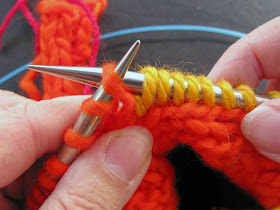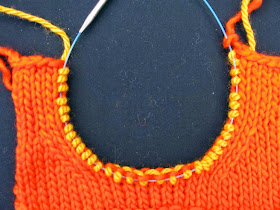In my last post I explained how I knitted a round neckline to make it as easy as possible to pick up the stitches for the neckband and achieve a neat clean finish. In this post I will show you how I pick up stitches around this neckline for the neckband.
This was the picture of the finished sample neckline from my previous blog. The stitches at the start of the neckline shaping are on a stitch holder and the decreases for the shaped section are worked 2 stitches in from the neck edge on each side. The neckline is finished with a section of straight knitting. It is important to be able to identify these different sections as you need to pick up stitches at different rates in the different sections.
The stitches on a stitch holder need to be slipped back onto a needle. It can be helpful to place a locking stitch marker in the edge opposite the top most decrease to remind you where the shaped section is. When picking up stitches in the straight section at the top I would pick up 3 stitches for every 4 rows. However in the shaped section the diagonal line created by the shaping means you need to pick up more stitches in this section and I usually pick up 1 stitch for every row here.
Start the pick up by holding the neckline in your left hand, starting at the top of the left hand edge of the neckline. When I pick up stitches I work between the edge stitch and the next stitch in, where I am pointing with my needle in the image above.
It is usual to knit the neckband on a smaller needle than is used for the main body of the knitting and this also makes it easier to pick up stitches using a smaller size needle. Holding a knitting needle in my right hand and the neckline in my left hand I push the point of the needle through the knitted fabric between the edge stitch and next stitch in.
I take the knitting yarn around the point of the needle (in this case I am using a contrast yellow yarn) and pull a new loop through to the front of the fabric. I repeat this process in the next 2 rows to pick up 2 more stitches.
Once I have picked up 3 stitches, I miss one row from the neckline (3 stitches to 4 rows) and then pick up another stitch in each of the next 3 rows. The image above shows the first 3stitches and then 2 strands pushed together, the 4th row, before the next stitch is picked up.
Once I have got to the start of the shaped section I pick up 1 stitch for every row. The image above shows the stitches picked up down one side of the neckline. It is important to make a note of how many stitches you picked up down the straight section and then how may stitches you picked up down the shaped section so that when you come to picking up the stitches on the opposite side you have the same number of stitches in each section.
One of the main problems a lot of knitters experience when picking up stitches for a neckband is that a hole appears between the stitches which have been shaped and the stitches on a stitch holder. To avoid this hole appearing I pick up the strand between the stitches forming the neckline and the stitches on a stitch holder as indicated in the image below.
Having picked up this strand onto the left needle point I knit into the back of the loop to make a new stitch and twist it shut to close any hole that might have formed. I have made a stitch, but this extra stitch can be decreased away in the next row if you feel you don't want it.
Having made a stitch to fill the hole I then continue working across the stitches that were on a stitch holder. Some patterns will tell you to cast off the stitches at the bottom of the neckline shaping but with a round neckline, which is often quite close fitting, I prefer to slip the stitches onto a stitch holder to keep the neckline as flexible as possible.
Once I have knitted all the stitches from the stitch holder I pick up the strand between the stitch holder stitches and the shaped neckline and make a new stitch, and then continue to pick up stitches along the shaped section and then the straight section at the same rates as I did on the first side of the neckline.
Once all the stitches have been picked up you should have a smooth, balanced neckline join. It is important when picking up stitches on the second side of the neckline to make sure you are working along the same channel of knitting as you did on the first side.
You can go straight into the neckband stitch pattern e.g. a knit 2 purl 2 rib after picking up the stitches or you can knit one row before starting the neckband pattern. Working a knit row gives a garter ridge detail that 'sits down' over the picked up row and can hide any minor irregularities and also can allow you to adjust the number of stitches at this point if you feel it is necessary. If you go straight into a rib pattern you need to work out what stitch you need to start with at the beginning of a Wrong Side row in order to have the rib pattern centred over the centre front of the neckband.
In this explanation I have shown you how to judge picking up stitches according to what you have knitted. Some knitters do not feel confident about picking up a different number of stitches to those given in a pattern. If that is the case I would suggest you divide your neckline into equal sections and place locking stitch markers or split pin markers through your knitting to mark of each section. Now divide the number of stitches you have to pick up by the number of sections you have marked. Working 1 stitch in from the edge as previously explained, pick up the number of stitches you have worked out in each section to get an even spread of stitches that are the same number as quoted in the pattern.
I hope this explanation and demo help with achieving perfect neckline finishes in the future.






































